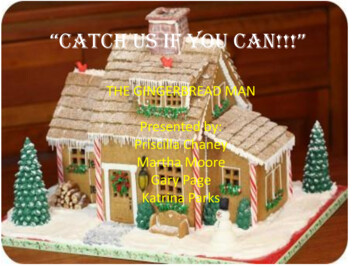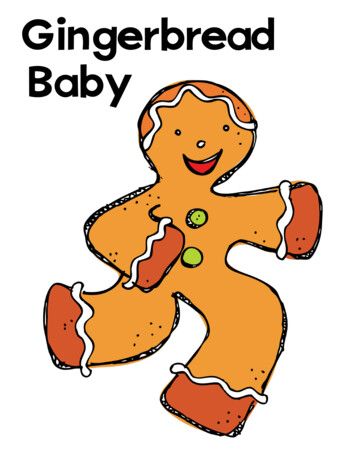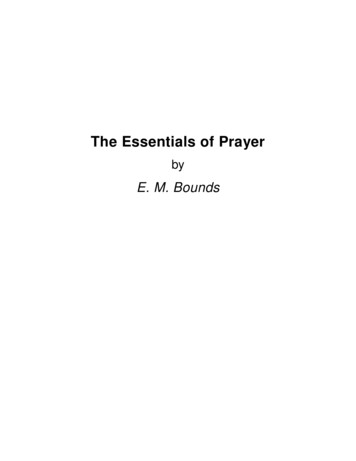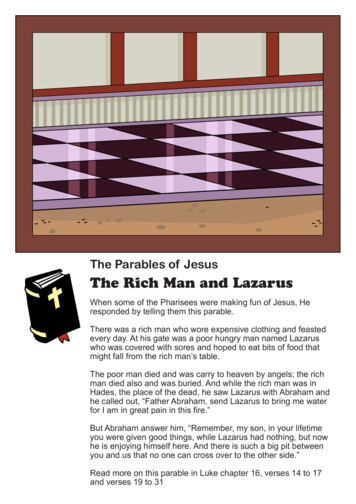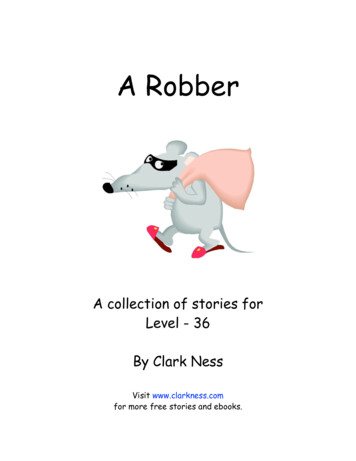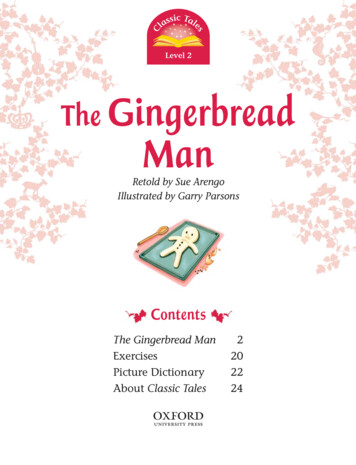
Transcription
Csssic TalelaLevel 2The GingerbreadManRetold by Sue ArengoIllustrated by Garry ParsonsContentsThe Gingerbread ManExercisesPicture DictionaryAbout Classic Tales 2202224
An old woman lives here. An oldwoman and an old man. Theydon’t have any children.2
The old woman’s in the kitchen.She’s making something. It’s agingerbread man.He has a head. He has arms and legs.He has two eyes, a nose, and a mouth.3
The old woman is happy.‘You’re a little boy,’ she says.‘My little boy!’‘In you go!’ says the old woman.In you go!4
Open the door!But soon the oldwoman hears a little voice.It’s coming from the oven.‘Open the door!’ says thevoice. ‘I want to come out!’The old woman opensthe oven door. And thegingerbread man jumps out.‘Oh!’ says the old woman.5
Come here!‘Stop!’ says the old woman. ‘Come here!’But the gingerbread man doesn’t stop.He runs across the kitchen and out ofthe door.6
‘Stop!’ shout the old manand the old woman.‘Come here!’But the gingerbread mandoesn’t stop. He runsfaster and he shouts:‘Run, run! You can run.Yes, you can! But youcan’t catch me. I’m thegingerbread man!’You can’t catch me.7
The little gingerbread man runs andruns. Soon he sees a cow.‘Stop!’ says the cow. ‘Come here! I wantto eat you.’But the gingerbread man doesn’t stop.He runs faster. And now the cow runsafter him.I want to eat you.8
‘I can run away from an old woman,’says the gingerbread man. ‘I can runaway from an old man. So I can runaway from a cow!’I can run away from a cow!They all run after him. And thegingerbread man shouts: ‘Run, Run!You can run. Yes, you can! But you can’tcatch me. I’m the gingerbread man!’9
The little gingerbread man runs and runs.Soon he sees a horse.‘Stop!’ says the horse. ‘Come here!I want to eat you.’Stop! Come here!But the gingerbread mandoesn’t stop. He runs faster.And now the horse runs after him.10
‘I can run away from an old woman,’says the gingerbread man. ‘I can runaway from an old man and a cow.So I can run away from a horse. Yes,I can! You can’t catch me. I’m thegingerbread man!’You can’t catch me.I’m the gingerbread man!11
The gingerbread man runs and runs.‘They can’t catch me!’ he says.‘Nobody can catch me.’Just then he sees a fox.‘Stop!’ says the fox. ‘Come here!’But the gingerbread man doesn’t stop.He runs faster. And now the fox runsafter him.12
‘I can run away from an old woman,’says the gingerbread man. ‘I can runaway from an old man. I can run awayfrom a cow and a horse. So I can runaway from a fox!’They all run after him and he shouts:‘Run, run! You can run. Yes, you can!But you can’t catch me. I’m thegingerbread man!’You can run. Yes, you can!13
I want to talk to you.‘Stop!’ says the fox. ‘I don’t want to eatyou. I want to talk to you. I want to befriends with you!’But the gingerbread man doesn’t stop.He runs faster. And now the fox runsfaster too.14
The gingerbread man runs and runs.Soon he sees a river.‘Oh no!’ he cries. ‘A river! I can’t swim!’‘Listen,’ says the fox. ‘I can help you.I can swim across and you can sit onmy tail.’I can’t swim!15
You are too big for my tail.So the gingerbread man sits on thefox’s tail. And the fox begins to swim.But soon the fox says, ‘Listen! You aretoo big for my tail. Sit on my back.’So the gingerbread man sits on thefox’s back.16
But soon the fox says, ‘Listen! You’retoo big for my back. Sit on my nose.’So the gingerbread man sits on thefox’s nose.17
The fox swims across the river andjumps out.The fox throws the gingerbread man up.Up! Up! Up!Then he opens his mouth and catches him!18
Help!‘Help!’ he says. ‘My legs! My legs!’‘Help!’ he says. ‘My arms! My arms!’Then the fox eats the gingerbread man’shead. Now the gingerbread man doesn’tsay anything.And that is the end. Yes, that is the endof the gingerbread man.19
Exercises1 What do they say? Write the words.12Youcan’tcatch me.3I want to4I want toto you.I can’t2 Put the words in the correct order.1 The kitchen woman’s in old the.The old woman’s in the kitchen.2 and little runs The gingerbread runs man.3 to with I be you want friends.4 river fox out across and The swims jumps the.20you.!
3 Make sentences about the story.1 The gingerbread man hastwo eyes, .2 The old woman opens theoven door .3 He runs away from .4 He sees a river .5 The fox says, .a cow and a horse.‘I can help you.’a nose, and a mouth.sits on the fox’s tail.but he can’t swim.and he jumps out.6 So the gingerbread man .4 Write the end of the story again, correcting the mistakein each sentence.The horse swims across the riverand jumps out. He throws thegingerbread man down. Then hecatches him in his arms. He eatsthe old man’s legs and arms.Then he eats the gingerbreadman’s mouth. That isn’t the endof the gingerbread man.The fox swims across the river and jumps out.21
Picture Dictionaryacross across the rivereyesfoxarmsheadbackhearcatchhorsecow22
jumpriverkitchenrun awaylegsshoutmouthtailnosethrowovenvoice23
Classic TalesClassic stories retold for learners of English – bringing themagic of traditional storytelling to the language classroom Level 1: 100 headwordsThe Enormous TurnipThe Little Red HenLownu Mends the SkyThe Magic Cooking PotMansour and the DonkeyPeach BoyThe Princess and the PeaRumpelstiltskinThe Shoemaker and the ElvesThree Billy-Goats Level 2: 150 headwordsAmrita and the TreesBig Baby FinnThe Fisherman and his WifeThe Gingerbread ManJack and the BeanstalkThumbelinaThe Town Mouse and the Country MouseThe Ugly Duckling Level 3: 200 headwordsAladdinGoldilocks and the Three BearsThe Heron and the HummingbirdThe Little MermaidLittle Red Riding HoodRapunzel Level 4: 300 headwordsCinderellaThe Goose GirlSleeping BeautyThe Twelve Dancing Princesses Level 5: 400 headwordsBeauty and the BeastThe Magic BrocadePinocchioSnow White and the Seven DwarfsAll Classic Tales have an accompanying e-Book with Audio Pack containing the book and thee-book with audio, for use on a computer or CD player.Teachers can also project the e-book onto an interactivewhiteboard to use it like a Big Book. Activity Book and Play providing extra language practiceand the story adapted as a play for performance in classor on stage.For more details, visitwww.oup.com/elt/teacher/classictales24 Great Clarendon Street, Oxford, ƭƶɁ ɅƢƮ United KingdomOxford University Press is a department of the University of Oxford.It furthers the University’s objective of excellence in research, scholarship,and education by publishing worldwide. Oxford is a registered trademark of Oxford University Press in the UK and in certain other countries /XFORD 5NIVERSITY 0RESS ɁȿɀɁThe moral rights of the author have been assertedFirst published in Classic Tales ɀɈɈɇɁȿɀɄ ɁȿɀɃ Ɂȿɀɂ10 9 8 7 6 5 4 3No unauthorized photocopyingAll rights reserved. No part of this publication may be reproduced,stored in a retrieval system, or transmitted, in any form or by anymeans, without the prior permission in writing of Oxford UniversityPress, or as expressly permitted by law, by licence or under termsagreed with the appropriate reprographics rights organization.Enquiries concerning reproduction outside the scope of the aboveshould be sent to the ELT Rights Department, Oxford University Press,at the address aboveYou must not circulate this work in any other form and you mustimpose this same condition on any acquirerLinks to third party websites are provided by Oxford in good faithand for information only. Oxford disclaims any responsibility for thematerials contained in any third party website referenced in this workƧƱƠƬ ɈɆɇ ȿ ɀɈ ɃɁɂɈȿɅ ɅThis Classic Tale title is available as an e-Book with Audio PackƧƱƠƬ ɈɆɇ ȿ ɀɈ ɃɁɂɈȿɈ Ɇ!LSO AVAILABLE The Gingerbread Man Activity Book and PlayƧƱƠƬ ɈɆɇ ȿ ɀɈ ɃɁɂɈȿɆ ɂPrinted in ChinaThis book is printed on paper from certified and well-managed d by 'ARRY 0ARSONS
1Storytelling ActivitiesUse these activities with your learners, for any story, to motivate them to listen and learn, and helpthem become aware of the sound and feel of English, and understand language points, while enjoyingthe story.Activities before the storyo Ten key words1. Write about ten key words or short phrases on the board in the order in which they occurin the story. Don’t worry if there are a few words the children don’t know.2. Ask them if they can predict the story (they can use the present tense to do this).3. Then tell the story. The children see the key words on the board and compare theirprediction with the story you tell.4. You can ask higher-level learners to work in groups and to write down each word in asentence which explains it.o Meaning from opposites1. It is often easier to teach two words that are opposite than one word by itself: big/small,rich/poor. This principle also applies to words which are not strictly opposites butrepresent concepts which are significantly different, for example love/hate. Draw or askthe children to draw contrasting pictures.Activities during the storyo Jump up word card1. Give a child a card before the story. You can either give each child a different word, or give thesame word to several of them.2. Ask them to jump up and sit down every time they hear their word as you tell the story.3. Variation: ask them to jump up whenever they hear a certain kind of word, for example a number,a colour or an animal. But make sure this is more like a game than a test.o Stopping and asking1. During the story, stop and ask the children what they think is going to happen next. Atbeginner level they reply in their mother tongue, and at higher levels they can reply withshort phrases or sentences in English.
1Activities after the storyo Restoring the text1. Prepare a text of the story, or part of it, on a photocopy or on the board. Omit, erase orwhite out some of the words. The number and type of words missing determine thedifficulty of the task.2. Give out the gapped text or write it on the board.3. The class fill in the gaps, either as you retell the story or on their own, or in pairs.o Removing pictures1. Prepare a series of pictures which tell the story.2. Display all the pictures. Go through the story again, eliciting as much of it as possiblefrom the children, using the pictures as a memory aid.3. The children close their eyes and you remove one picture.4. The children then open their eyes and tell you which picture is missing and which part ofthe story it represents.5. The children close their eyes again. You now remove another picture and they tell youwhich one is missing.6. Gradually remove all the pictures and see if they can retell the story from memory.o Writing letters1. Ask the children to write letters from one character to another. This can be part of a widertopic on learning on how to write letters.These activities are from Wright, A (2008) Storytelling with Children Oxford University Press pp.31-61
the story. Activities before the story o Ten key words 1. Write about ten key words or short phrases on the board in the order in which they occur in the story. Don't worry if there are a few words the children don't know. 2. Ask them if they can predict the story (they can use the present tense to do this). 3. Then tell the story.

